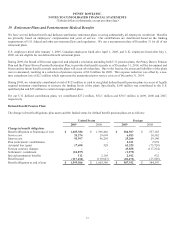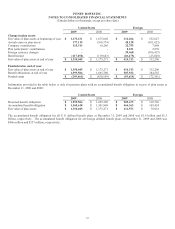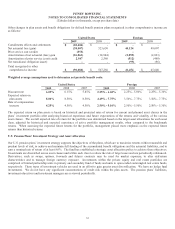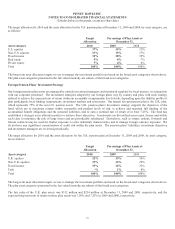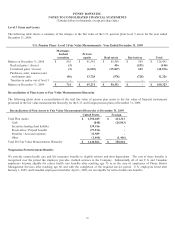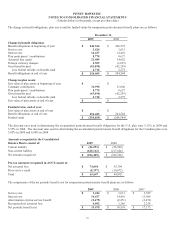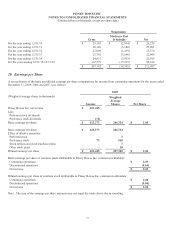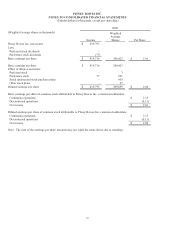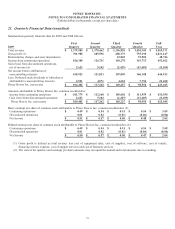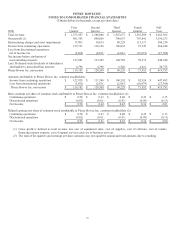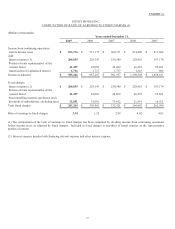Pitney Bowes 2009 Annual Report Download - page 105
Download and view the complete annual report
Please find page 105 of the 2009 Pitney Bowes annual report below. You can navigate through the pages in the report by either clicking on the pages listed below, or by using the keyword search tool below to find specific information within the annual report.PITNEY BOWES INC.
NOTES TO CONSOLIDATED FINANCIAL STATEMENTS
(Tabular dollars in thousands, except per share data)
87
The following information relates to our classification of investments into the fair value hierarchy:
xMoney Market Funds: Money market funds typically invest in government securities, certificates of deposit, commercial
paper of companies and other highly liquid and low-risk securities. Money market funds are principally used for overnight
deposits. The money market funds are classified in Level 2 of the fair value hierarchy since they are not actively traded on an
exchange.
xEquity Securities: Equity securities include U.S. and foreign common stock, American Depository Receipts, preferred stock
and commingled funds. Equity securities classified in Level 1 of the fair value hierarchy are valued using active, high
volume trades for identical securities. Equity securities classified in Level 2 of the fair value hierarchy represent those not
listed on an exchange in an active market.
xDebt Securities - U.S. and Foreign Governments and its Agencies and Municipalities: Government securities include treasury
notes and bonds, foreign government issues, U.S. government sponsored agency debt and commingled funds. Municipal
debt securities include general obligation securities and revenue-backed securities. Debt securities classified in Level 1 of the
fair value hierarchy are valued using active, high volume trades for identical securities. Debt securities classified in Level 2
of the fair value hierarchy are valued through benchmarking model derived prices to quoted market prices and trade data for
identical or comparable securities.
xCorporate Debt Securities: Investments are comprised of both investment grade debt (BBB-) and high-yield debt (BBB-).
The fair value of corporate debt securities is estimated using recently executed transactions, market price quotations where
observable, or bond spreads. The spread data used are for the same maturity as the security. These securities are classified in
Level 2 of the fair value hierarchy.
xMortgage-Backed Securities (“MBS”): Investments are comprised of agency-backed MBS, non-agency MBS, collateralized
mortgage obligations, commercial MBS, and commingled funds. These securities are valued based on external pricing
indices. When external index pricing is not observable, mortgage-backed securities are valued based on external price/spread
data. If neither pricing method is available, we then utilize broker quotes. When inputs are observable and supported by an
active market, mortgage-backed securities are classified as Level 2 in the fair value hierarchy. When inputs are
unobservable, mortgage-backed securities are classified as Level 3 in the fair value hierarchy.
xAsset-Backed Securities (“ABS”): Investments are comprised of credit card receivables, auto loan receivables, student loan
receivables, and Small Business Administration loans. These securities are valued based on external pricing indices or
external price/spread data. Asset-backed securities are classified as Level 2 in the fair value hierarchy.
xPrivate Equity: Investments are comprised of units in fund of fund investment vehicles. The fund of fund vehicles consist of
various private equity investments and are used in an effort to gain greater diversification. The investments are valued in
accordance with the most appropriate valuation techniques. These investments are classified in Level 3 in the fair value
hierarchy due to the unobservable inputs used to determine a fair value.
xReal Estate: Investments include units in open-ended commingled real estate funds. The properties that comprise these funds
are valued externally by an independent appraiser using the most appropriate valuation techniques. These investments are
classified in Level 3 in the fair value hierarchy due to the unobservable inputs used to determine a fair value.
xDerivatives: Instruments are comprised of futures, forwards, options and warrants and are used to gain exposure to a desired
investment as well as for defensive hedging purposes against currency and interest rate fluctuations. Derivative instruments
classified in Level 1 of the fair value hierarchy are valued through a readily available exchange listed price. Derivative
instruments classified in Level 2 of the fair value hierarchy are valued using observable inputs but are not listed or traded on
an exchange. Derivative instruments classified in Level 3 of the fair value hierarchy are valued using unobservable inputs.
xSecurities Lending Fund: Investment represents a commingled fund through our custodian’s securities lending program. The
U.S. pension plan lends securities that are held within the plan to other banks and/or brokers, for which we receive collateral.
This collateral is invested in the commingled fund, which invests in short-term fixed income securities such as commercial
paper, short-term ABS and other short-term issues. Since the commingled fund is not listed or traded on an exchange, the
investment is classified as Level 2 in the fair value hierarchy. The investment presented in the fair value hierarchy is offset
by a liability of an equal amount representing assets that participate in securities lending program, which is reflected in the
Pitney Bowes Pension Plan’s net assets available for benefits.






